- PRODUCTS
- RECORDERS
- SUPPORT
| Home > Pipeline Newsletters > VITA 49: The Future of Software Radio |

|
|
Spring 2016 Vol. 25, No. 2 |
|
VITA 49: The Future of Software Radio by Rodger Hosking, Pentek, Inc. The use of software radio technology has spread to almost every commercial, consumer, government, industrial, and military platform across the entire radio frequency spectrum during the technology's 25-year lifespan. Innovations in data converter technology, DSP devices, system interconnects, processors, software, design tools, and packaging techniques have improved performance levels and reduced the size, weight, and power consumption of software radio systems. However, the rapid surge in software radio applications spawned ad hoc, proprietary interfaces between the elements in these systems. 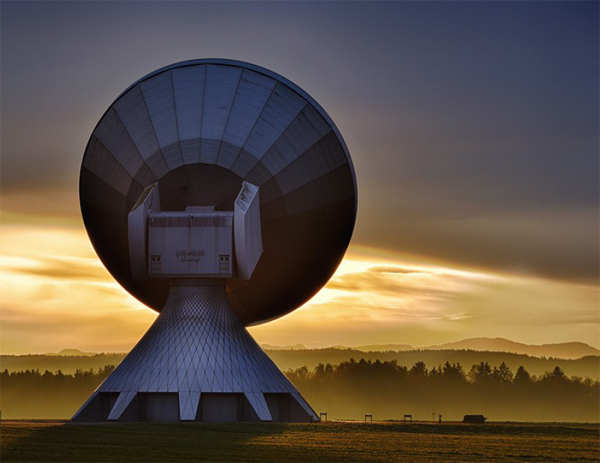 More than ten years ago, government and military customers realized this complexity was undermining software radio's reliability and maintainability as well as hindering feature upgrades and technology refresh cycles. They also wanted to improve compatibility between vendors and reuse software radio hardware platforms for different types of signals and new applications in the future. So those interested in addressing these issues started work on VITA 49.0, which became known as VRT, for VITA Radio Transport. This article describes the challenges inherent in traditional software radio architectures, how the VRT protocol addresses those challenges, and how additions and refinements to VRT will provide even more benefits to software radio technology. Traditional Software Radio ArchitectureThe essence of software radio is the replacement of analog radio functions with digital signal processing. But, because all software radio systems ultimately need some analog RF connection to an antenna, they always include some analog circuitry between the antenna and the digitizer. This critical link provides gain, filtering, frequency translation, and other operations to ensure that the digitizer responsibly captures the signal band of interest while minimizing aliasing, distortion, and noise. Because ADCs with the highest resolution operate at lower input signal frequencies, high frequency RF signals are usually translated to lower IF frequencies before digitizing to maximize dynamic range. These digitized signals are then exploited by the appropriate DSP hardware and software to meet the tasks at hand. 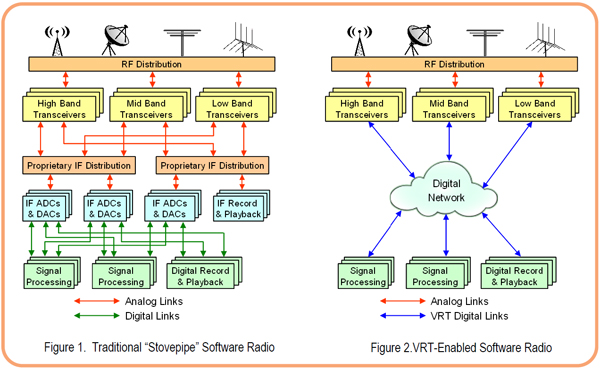 Figure 1 shows the typical topology of a traditional multiband software radio system, often referred to as "stovepipe" architecture. The red lines show analog signal paths consisting of coaxial cables, connectors, distribution amplifiers, and switches. Each path satisfies the specific signal routing requirements of a particular installation, analogous to fitting a series of different sections of stovepipe between a wood stove and the chimney. Multiple ADC and DAC blocks provide the analog/digital interface between analog IF signals and digital IF samples. Even after digitizing, stovepiping techniques are continued to distribute the digital IF signals to connect the various signal processing blocks required, as shown in green. And, each of these digital links might require unique signal levels, data rates, bit widths, and protocols. This complex and proprietary maze of interconnections not only undermines reliability and maintainability, but also impedes feature upgrades and technology refresh cycles. VRT to the rescue! A Better Way: VRT-Enabled Software RadioFigure 2 shows the system concept for VRT. Notice the critical RF analog connections to the antennas remain essentially the same, but the transceivers now incorporate the analog RF signal conditioning, translation to IF, and the ADC and DAC functions. These transceivers now send and receive digitized IF signals shown in blue lines as VRT Enabled Digital IF links, replacing most of the analog signal distribution shown in Figure 1. These VRT links are routed through COTS network switches to the appropriate signal processing blocks, providing flexible interconnections that can easily accommodate functional changes, upgrades, and new technology insertion. The VRT protocol does not specify a specific physical layer or link layer, so it can be delivered across virtually any link that supports packets. 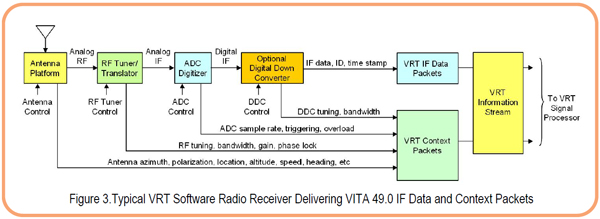 While such connectivity is valuable, VRT boosts the significance of these signal streams by coupling them to critical information about the signals, called metadata. Figure 3 shows the typical blocks of a software radio receiver. The RF Tuner/Translator and ADC produce digital IF samples, which can be optionally down-converted with a DDC to produce baseband samples instead of IF samples. Operational parameters for all sections of the receiver are delivered by various means from a system controller. So far, this architecture is fully consistent with the essential blocks of a conventional software radio receiver. Transforming it into a VRT receiver consists of organizing the IF output data samples into structured packets, which also contain header information for stream ID and a time stamp, thus forming the VRT IF Data Packets. In addition, operating parameters of each element are gathered and inserted into well-defined fields of VRT Context Packets. Together, the VRT IF Data Packets and Context Packets form the VRT Information Stream ready for processing by a VRT Signal Processor, which knows precisely how to extract the data and process it according to its context from the metadata. VRT Benefits Key ApplicationsSoftware radio SIGINT and COMINT systems attempting to locate, identify, and monitor a wide range of unknown signals can extract many useful facts from the VRT Information Stream. These can include the azimuth and elevation of a directional antenna, the reference power level of the RF signal, the bandwidth and tuning frequencies of the RF tuner and DDC, the sample rate of the ADC, the frequency accuracy RF tuner and sample clock, a signal ID tag, and the time stamp. Particular emphasis is devoted to time stamp accuracy. VRT time stamps allow beamforming applications to compare absolute time and phase differences between signals received from multiple antennas to calculate distance, location, speed, and heading of a transmitter. Likewise, a multi-element diversity receiver can exploit VRT time stamps to create delays and phase shifts in each antenna signal path to maximize receptivity in a particular direction. Absolute time can be derived from GPS receivers, so that software radio receivers separated by great distances can be synchronized to capture signals at the same time. This can be very useful for tracking signals from satellites or even from sources in deep space. Radar systems must capture reflected pulses during precise intervals of time relative to the outgoing radar pulse, usually defined as a range gate. When the received data is captured, VRT delivers a time stamp to the radar processing engine, showing the exact arrival time of the return signal. Before VRT, systems relied on complicated local interfaces between the receiver and the processor to ensure coherency for a given task. VRT provides an elegant solution by encapsulating parameter and timing information along with the data. A major benefit here is that the VRT Information Stream can be delivered to any number of remote processing facilities, while fully preserving the critical metadata and time stamp. VRT Evolves and Improves via VITA 49.2Approved as an ANSI standard in 2007, VITA 49.0 represented the first official standard for VRT, but it only defined receiver functions using the VRT IF Data and Context packets, as shown in Figure 4. After demonstrating its usefulness by early adopters, system designers wanted to extend its scope to encompass even more elements of software radios. The original VITA 49.0 standard omits support for transmitters, control and status functions, and any signals other than digital IF. 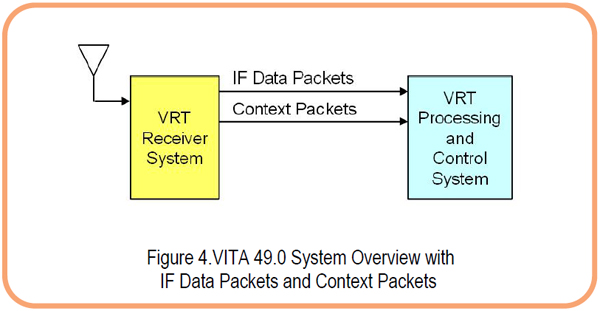 To address these shortcomings, a new initiative called VITA 49.2 is now underway, with new packet classes represented in Figure 5. The original IF Data Packet is replaced with the Signal Data Packet, which not only supports digitized IF signals, but also baseband signals, broadband RF signals, and even spectral data. Signal Data Packets are backwards compatible with IF Data Packets, with new identifier bits specify the data type. 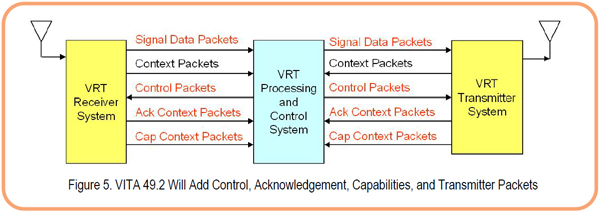 To support both sides of radio, Signal Data Packets can now be used for transmit data, supporting baseband, IF, and RF signals. Here, the time stamp dictates the transmit time, which is especially useful for generating precisely-timed radar pulses. Multi-static radar systems use one antenna for transmitting pulses and other remotely located antennas for capturing the reflected pulses. Through GPS synchronization, VRT can be used to coordinate transmit and receive signals at each site. Spectral survey systems are in widespread use for detecting and recording signals of interest. Under VITA 49.2, Signal Data packets can carry digitized spectral information from scanning receivers, and deliver packets to analysts anywhere in the world. These packets maintain full context information regarding location, circumstances and conditions, as well as a precise time stamp. Gaining ControlAnother deficiency of VITA 49.0 was its lack of control of software radio resources. Figure 3 highlighted many of the common parameters needed for each radio element and the importance of reporting them through Context Packets. VITA 49.2 adds a new packet class called Control Packets, which allow the VRT System Processor to deliver operating parameters to each element using standardized fields and formats. This supports a consistent control interface across a wide class of hardware, ranging from antenna positioning systems to transmit power amplifiers. The original Context Packet is also significantly enhanced in VITA 49.2. Many more types of metadata are supported for new details and richer information about the signal data. As a natural consequence of adding VRT Control Packets, Context Packets were also extended by adding new Acknowledge Context Packets to verify successful completion of the control commands. In response to each Control Packet, they not only report current operating parameters but highlight any discrepancies or problems in executing the new commands. This comprehensive and complimentary control/status protocol of VRT provides an essential function for cognitive radio, adaptive spectral management, electronic counter measures, and other critical applications. Capabilities Context PacketsBecause each software radio resource is unique, VITA 49.2 added yet another type of Context Packet called the Capabilities Context Packet. This allows a VRT resource to respond to the system with a complete set of its operational specifications including minimum and maximum limits of each programmable parameter. This may include frequency tuning range, bandwidth settings, range of programmable gain, antenna azimuth angle limits, and range of transmit power levels. Capabilities Context Packets also provide additional characteristics such as:
In theory, a VITA 49.2 System Processor can connect to a new, unknown software radio resource and automatically discover everything it can do, how to control and monitor its operation, and how to successfully exchange receive and transmit signals. In practice, Capabilities Context Packets will be most useful when developing new applications on existing platforms, and in reacting responsibly to new threats or circumstances during deployed operations. Putting VRT to WorkMany vendors are now delivering VITA 49.0 compliant products. Fortunately, adding VRT features to a legacy software radio product is a reasonable effort, especially if it contains an FPGA. In response to a customer requirement, Pentek modified one of its most popular software radio XMC modules to deliver VITA 49.0 output packets containing precise time stamping, stream identification, and baseband signal data samples. Since all of the required underlying functional blocks had already been implemented in a Virtex-6 FPGA, most of the modifications involved formatting the data samples, timing counters, and stream ID parameters. Then a VITA 49.0 state machine was created to form VRT IF Data Packets by filling in the appropriate parameter fields. A software switch allows selection of the original output mode or the new VITA 49.0 protocol. Looking AheadBecause of its extensive scope and promising benefits, VITA 49.2 is still under development in the VSO working group, with balloting expected in the near future by active members representing three major interest groups:
Participants from each of these three groups are motivated by the many tangible benefits derived from their efforts. Like any successful standard, VITA 49.0 continues to evolve as new technology emerges, and through feedback from realworld deployment. With so many clear benefits and relatively little extra complexity, VRT is expected to mark the trail for new and future software radio systems. |
 |
| CONNECT ON SOCIAL: |
|
|
|
|